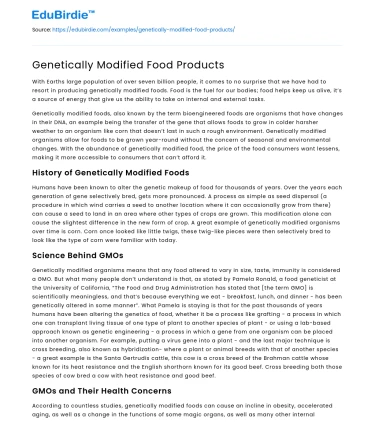With Earths large population of over seven billion people, it comes to no surprise that we have had to resort in producing genetically modified foods. Food is the fuel for our bodies; food helps keep us alive, it’s a source of energy that give us the ability to take on internal and external tasks.
Genetically modified foods, also known by the term bioengineered foods are organisms that have changes in their DNA, an example being the transfer of the gene that allows foods to grow in colder harsher weather to an organism like corn that doesn’t last in such a rough environment. Genetically modified organisms allow for foods to be grown year-round without the concern of seasonal and environmental changes. With the abundance of genetically modified food, the price of the food consumers want lessens, making it more accessible to consumers that can’t afford it.
Save your time!
We can take care of your essay
- Proper editing and formatting
- Free revision, title page, and bibliography
- Flexible prices and money-back guarantee
History of Genetically Modified Foods
Humans have been known to alter the genetic makeup of food for thousands of years. Over the years each generation of gene selectively bred, gets more pronounced. A process as simple as seed dispersal (a procedure in which wind carries a seed to another location where it can occasionally grow from there) can cause a seed to land in an area where other types of crops are grown. This modification alone can cause the slightest difference in the new form of crop. A great example of genetically modified organisms over time is corn. Corn once looked like little twigs, these twig-like pieces were then selectively bred to look like the type of corn were familiar with today.
Science Behind GMOs
Genetically modified organisms means that any food altered to vary in size, taste, immunity is considered a GMO. But what many people don’t understand is that, as stated by Pamela Ronald, a food geneticist at the University of California, “The Food and Drug Administration has stated that [the term GMO] is scientifically meaningless, and that’s because everything we eat - breakfast, lunch, and dinner - has been genetically altered in some manner”. What Pamela is staying is that for the past thousands of years humans have been altering the genetics of food, whether it be a process like grafting - a process in which one can transplant living tissue of one type of plant to another species of plant - or using a lab-based approach known as genetic engineering - a process in which a gene from one organism can be placed into another organism. For example, putting a virus gene into a plant - and the last major technique is cross breeding, also known as hybridization- where a plant or animal breeds with that of another species - a great example is the Santa Gertrudis cattle, this cow is a cross breed of the Brahman cattle whose known for its heat resistance and the English shorthorn known for its good beef. Cross breeding both those species of cow bred a cow with heat resistance and good beef.
GMOs and Their Health Concerns
According to countless studies, genetically modified foods can cause an incline in obesity, accelerated aging, as well as a change in the functions of some magic organs, as well as many other internal issues. Others are also concerned about the pesticides introduced to the genetic makeup of plants, but according to recent studies poisons in plants have no harm to humans. Genetically modified organisms and the act or creating them is considered one of the most controversial sciences to this day. Because on the other side of the spectrum many researches state that genetically modified food causes no harm to one’s body.
GMOs and Their Financial Benefits
Although genetically modified foods aren’t the healthiest option, their financial benefits tend to exceed the organism’s health risks. Over 70% of the foods in your local grocery store is transgenic (have been genetically modified) If GMOs were to stop being produced, prices would start to rise and there would be a decrease in what the customer/consumer can actually buy. The first group of people that would be affected negatively by this change would be the lower class. Since The United States doesn’t have such harsh laws on genetically modified organisms, unlike other countries such as France, Germany, and Austria, genetically modified foods are more accessible to those with lower incomes. Genetically modified foods are more cost effective, thus helping out the economy.
The Government and GMOs
President Barack Obama was in accordance with and signed a country wide mandatory GMO labeling law. Requiring all genetically modified foods that are sold are to have a label stating the presence of genetically modified organisms in the product. While is seems to be a step in the right direction, the labeling is very vague and sometimes confusing. Instead of outright labeling products that have GMOs, the labels can sometimes include a number to call in order to find out if GMOs exist in the product, or other abbreviations that people aren’t familiar with.
The Future for GMOS
While genetically modified foods have existed for a pretty long time, the technological advancements we’ve made can cause some concern about the safety on what exactly we are putting in our food, whether it be naturally occurring or through a laboratories approach. In the end, with such a financial benefit in the food production industry that’s too hard to ignore, it might be more difficult to get the proper evaluation and ‘labeling’ of GMO products. Given people’s stances on the bioengineering point of view, all that’s really wanted is clarification and safety of the products people are ingesting, but it doesn’t seem like it’s going to be clarified anytime soon.






 Stuck on your essay?
Stuck on your essay?

